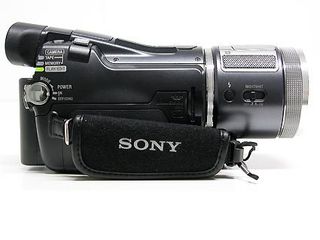Sony HDR-HC1: A Quantum Leap For Video Buffs
Introduction

The Sony HDR-HC1E costs upwards of $1,200 and is aimed at ambitious video buffs. It's not as well-suited for first-time home video makers, but for users with some DV experience it is a very interesting offering.
It's taken a long time for us to finally get our hands on the Sony DCR-HC1E, the smallest HD video camera available, even though it has been available for several months now. But our time with this product has made us understand why many digital video buffs are pondering a difficult question: Is it time to upgrade to HD video, now that Sony supports the 1080i format?
Several facts argue in favor of upgrading. The HC1 can record onto current DV cassettes in HD format (1440x1080 pixels) or in conventional DV format (720x576 pixels). Supporting the lower resolution DV format might seem an odd choice, but it enables the camcorder to play back old-style DV tapes; perhaps encouraging ambitious videomakers to consider abandoning their old DV cameras completely. So is the Sony HC1 the right HD camcorder for those who are ready to trade up?
The benefits of the new technology are apparent by looking at the numbers: HD video on the Sony HC1 covers 1,555,200 pixels, while current DV video delivers about one-fourth that resolution, at 414,720 pixels. The camcorder normally operates in interlaced (1080i) mode (where half a frame of data is captured at double the full-frame rate). As in earlier implementations, the data rate for sound and image combined is 3.6 MB/s - the same when recording either HD or DV video streams.
Of all the HD video cameras currently available for sale, the Sony HC1 is the least costly one that enables videographers to capture new images and experiences at high resolution. Its technology comes primarily from the Sony FX1, which costs twice as much, and is also much larger and heavier. Sony has also trimmed back on standard features for the HC1 compared to the FX1, but that shouldn't bother DV moviemakers ready to upgrade to HD.

The large camera lens on the HC1, with its Nightshot switch, is especially noticeable. You can also turn on an image stabilizer to compensate for camera motion. Other than that, you get very few external controls to operate this device.
Along with the camera's portability, its compatibility with appropriate video editing software is another strong point in its favor. In fact, the raw footage is intended to be transferred to a suitably-equipped PC, where it can be cut and reworked as necessary. To give you a feel for how that all works, we used the latest software versions from two established vendors: Adobe Premiere Pro 2.0 and Pinnacle Studio Plus 10.5. We ran into some deficiencies in this department, however, which we'll discuss later on.
Stay on the Cutting Edge
Join the experts who read Tom's Hardware for the inside track on enthusiast PC tech news — and have for over 25 years. We'll send breaking news and in-depth reviews of CPUs, GPUs, AI, maker hardware and more straight to your inbox.
Note that we have included downloadable videos in full HD, DV and VHS resolutions. So with the investment of a little downloading time, readers wrestling with this decision, or simply curious, can see the HD difference for themselves.

Controls for the most important settings - lighting, white balance, and so forth - use the touch screen. The swing-open monitor on the camera works well as a recording control, as long as ambient light levels aren't too high.
Most Popular

